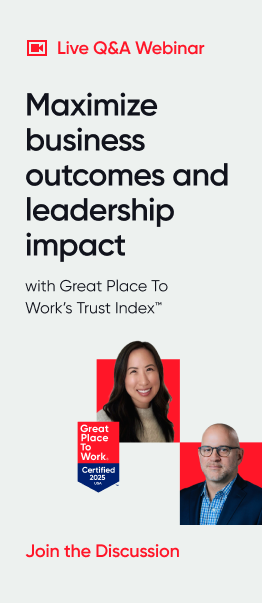Developing, High-trust leadership, Training & Development
Developing — one of the nine high-trust leadership behaviors — requires leaders to find the potential in employees that they might not see for themselves.
Companies desperately need to reskill employees as technology like AI promises to revolutionize the workplace.
Eight in 10 (82%) of leaders say their employees need new skills to be prepared for AI, according to a Microsoft survey. Data from IBM argues that companies have just three years to upskill their workforce.
Employees also expect to have opportunities to learn and grow in their role.
Nine in 10 (91%) respondents in the 2023 Work In America Survey from the American Psychological Association said it was very or somewhat important to them to have consistent opportunities to learn
In the survey, workers who were satisfied with their opportunities for growth were more likely to report good or excellent mental health (79%). Workers who lacked opportunities for growth and advancement were also more likely to feel tense or stressed during their workday (66% vs. 42%).
Attend our annual company culture conference May 7-9, 2024
The ability to develop and grow employees is a crucial leadership trait, one of the nine high-trust leadership behaviors that build trust at the Best Workplaces™.
“It’s [a leader’s] job to help employees grow as people, not just performers,” says Michael C. Bush, CEO of Great Place To Work®.
The best leaders in today’s workplaces are active mentors and coaches. They provide opportunities for employees to stretch and learn new skills, and give actionable feedback with measurable outcomes attached to nurture career growth.
To be successful, leaders must be curious about the goals and dreams of their people. Conversations about development and growth are only unlocked once employees know that their leaders care about them.
“When people know you care — even if they don’t always like hearing where they need to improve — they’ll take it as a gift,” Bush says. “Everybody wants to get better.”
Most companies have programs for learning and development, but not every employee can participate. The Best Workplaces ensure that every employee, regardless of role or educational background, has the resources and opportunities to develop their careers.
Here’s how leaders at great workplaces are developing their employees:
1. Use AI tools to personalize conversations around development and growth
Does every employee have regular discussions with a manager about their performance and growth opportunities? It’s an essential piece of the puzzle when creating an equitable workplace.
“If you’re not having one-on-one conversations with your folks about what’s important to them, their performance, what they want to grow into, they can’t grow,” says Marcus Erb, vice president of data science and innovation at Great Place To Work. “And fundamentally, they’ll never experience a fair sense of growth.”
At ServiceNow, No. 68 on the Fortune 100 Best Companies to Work For® List in 2024, growth conversations are “always on.” Employees can expect performance feedback at any time they seek it and are empowered to take ownership of their individual learning and development plans — with a little help from artificial intelligence.
Once employees have a clear goal, they can take advantage of ServiceNow’s learning platform “frED” which suggests and matches employees with courses and trainings from ServiceNow and its education partner Udemy. When mapping their career path, employees can get AI recommendations to develop the necessary technical and soft skills for their next role.
2. Ensure every employee, regardless of role, can participate
Some employees are often overlooked when companies are designing learning content. The Best Workplaces stand out for their ability to connect every employee with opportunities for advancement.
At Walmart, which made the 100 Best list this year at No. 97, programs like its Associate to Driver initiative offer frontline associates with unique opportunities to develop skills and build rewarding careers. The 12-week Associate to Driver program allows associates working in stores, fulfillment centers, and transportation offices to earn their commercial driver’s license, and become drivers, making up to $110,000 in their first year.
“Associates are increasingly viewing continuous learning as a key part of their career — often fueled by technological change,” says Donna Morris, chief people officer at Walmart. “As a result, we’re equipping associates with skills training that allows them to gain the skills needed to advance even faster.”
These investments translate into an impressive amount of internal mobility for employees, with 88% of U.S. roles above entry-level being filled internally in the 2023 fiscal year.
3. Identify people internally by their skills, not credentials
To unlock the full potential of your workforce, leaders must look beyond what employees look like on paper. Companies like Delta Air Lines, No. 94 on the 100 Best list, are removing college degree requirements from jobs to open their doors to a bigger talent pool.
“Honestly, I’d rather hire people with great skills,” said Ed Bastian, CEO of Delta said in a Fortune webinar celebrating the 100 Best Companies to Work For.
Instead, companies are creating profiles for their employees to identify and track skills and connect internal talent with opportunities across the business.
"If you’re not having one-on-one conversations with your folks about what’s important to them, their performance, what they want to grow into, they can’t grow."
At American Express, No. 4 on the 100 Best list in 2024, a career and development plan is available to all employees via its talent, learning, and performance management platform, “Navigator.” Employees have access to the plan at any time, beginning with their onboarding experience.
“When colleagues access the tool, they are prompted to reflect on their career journey, thinking through and sharing where they’ve been, how they want to grow, and what support they will need along the way,” says Sonia Cargan, SVP and chief talent officer at American Express.
After sharing their skills, experiences, and personal strengths with the tool, employees can export a one-page snapshot that functions as an internal résumé when meeting with leaders or mentors inside the company. This snapshot then becomes a crucial tool for having productive conversations about their career and opportunities for growth.
Artificial intelligence can be involved here, as well. Companies are increasingly creating internal talent marketplaces where technology matches an employee’s skill profile with an opportunity within the company.
4. Meet employees where they are
Don’t assume that every new hire, or even employees that have been with the company for decades, are starting from the same place on their learning and development journey.
Different groups of employees can be missing skills that will result in a mid-career slump. Instead, leaders must create experiences that address the specific needs of individual employees. At The Progressive Corporation, No. 35 on the 100 Best in 2024, its Multicultural Leadership Development Program offers 12 to 18 months of workshops and projects, supporting the companies diversity, equity, inclusion & belonging (DEIB) objectives to develop the leaders it needs to meet targets for representation.
“From the beginning, it was important that this program was not intended to ‘fix’ anybody,” says Marisa Afzali, director of diversity, equity, and inclusion at Progressive. “Rather, it was to tap into the enormous talent already existing within Progressive and to find ways to support, provide exposure for, and help individuals realize their talents and apply them in new ways.”
Employee resource groups can be essential for connecting workers from different backgrounds with growth opportunities. Make sure your ERGs have clear goals for developing members and provide access to senior leaders and growth opportunities.
5. Formalize the structure for mentorship and sponsorship throughout the organization
Mentorship and sponsorship can play a big role in the career development of employees.
The best workplaces don’t leave such important relationships to chance. At Cadence, No. 9 on the 100 Best list, employees connect through software called Chronus and are paired into mentor/mentee relationships across the organization.
“When people know you care — even if they don’t always like hearing where they need to improve — they’ll take it as a gift."
Pairings are highly intentional, and managers are made aware of their employees’ participation in the mentorship program to ensure they can reinforce the relationships and lessons learned.
When creating a mentorship program, set clear goals for both mentors and mentees.
“If you just say, ‘Be a mentor,’ that's a little bit too open,” says Jerome Goyhenetche, group director, culture and talent development, at Cadence. “You can’t just wait for the mentor to do all the work and to provide all the wisdom.”
Join the movement
Hear from leaders at companies that made the Fortune 100 Best Companies to Work For list at our For All™ Summit, April 8-10, 2025 in Las Vegas, NV.











